Photo
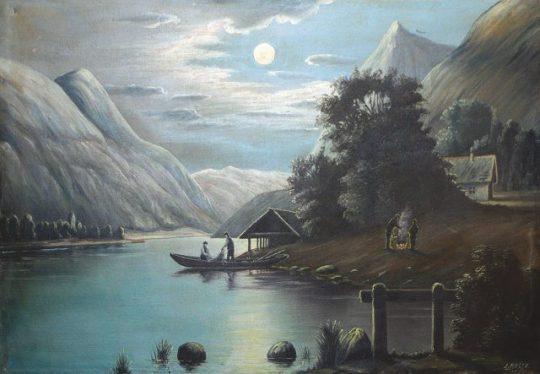
(Untitled painting by Livonian Latvian painter Jāņ Bēļța (1893-1946). Only about 18 of his paintings are currently known)
Silver Grave
I wade in the wavy silver shallows,
Pearls and amber roll beneath my feet,
I squeeze the very silver with my toes.
I wade further into the silver floodplains
How cool the silver is, how gentle it feels!
The silver already now reaches my knees!
And higher it climbs around my limbs
Now silvery ivy twisting
Around my pale thigh-columns it winds.
Up to my burning chest
From my hips is a pillar
Blanketed now in silver waves.
Already my red blood like icy frost
Turns to silver, flowing through my flesh
My heart thumping like a silversmith's hammer.
The silver rides higher, splashes thrown,
It closes my eyelids
Sprinkling eyelashes with silver.
I am swayed by the silver lullaby -
Lifted up on the water’s surface
Only the two gulls of my palms. -
Soon they too will be swallowed up
And a white waterlily alone
Will grow on my silver grave.
- Aspazija (1865-1943) (From her collection: In The Time Of Asters - Autumn Poems, 1928)
My translation from the Latvian; see Keep Reading for the Latvian original.
SUDRABA KAPS
Es brienu pa viļņu sudraba grīdu,
Zem kājām man pērles un dzintars rit,
Es sudrabu pašu kājām mīdu.
Es brienu tālāk pa sudraba paliem:
Cik sudrabvēsi, cik maigi man tiek!
Jausudrabs man sniedzas līdz ceļu galiem!
Un augstāk jau apvij stīdzenītes
No sudrabotām efejām
Ap baltām gūžu kolonnām vītes.
Līdz krūšu sarkanām ugunsdegām
No gūžu baltām kolonnām
Sedz viļņi visu ar sudrabsegām.
Jau sarkans asins par sudrabu salis,
Kā tekošs sudrabs man miesās rit,
Sirdsāmurīts sit kā sudrabkalis.
Kāpj sudrabs augstāk un mētā šļakstus
Un acuvākus man cieti slēdz,
Un pieber ar sudrabu acu plakstus.
Un mani iešūpo sudraba aijās —
Uz ūdens virsu tik paceļasV
ēl manu plaukstu divas kaijas.—.
.. Sen arī tās jau norītas tapa —
Un baltā ūdensroze vien
Aug virsū uz mana sudraba kapa.
- Aspazija
26 notes
·
View notes
Photo
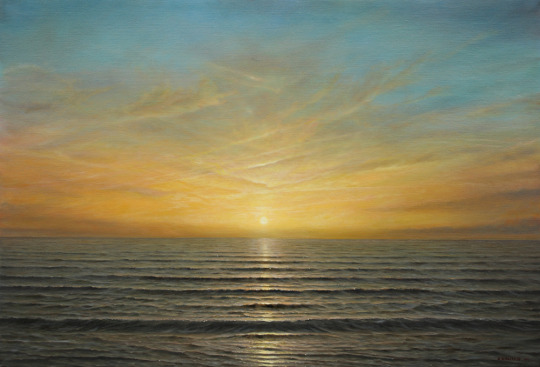
Painting: The Sky in the Sea, Belongs to Me, by Aigars Rinkulis (1970-2013)
The Violet “Ave”
The sea surface lies heavy, like molten tin…
Then suddenly it shows itself sun-crowned:
In flaming glory the sun sets westwards
Searching amongst cool waves for its grave
Bit by bit disappearing as it treads the red dunes,
Leaving the earth behind to its darkness and pain,
Here now it disappears, - but the waves before it, take its life
And they shine, and shimmer, and mirror, and slide and splash;
The grey coast of even stoney hues
Bursts into branching flashes like a ruler’s crown
And sounds, flowing from afar on the waves,
Sweet melodies, breaking in anguish:
“The sun was gold,
Now sallow, deathly old,-
There were path of light,
Now linen and night, -
There was burst of beams,
Now the darkness teems, -
Fading, light fading!
Fear and vapours - dismaying!”
Bells toll with heavy tongues clanging,
Winds cry on the shivering zither strings,
All the little fish tremble.*
And cry along.
The mermaids’ pearly jewellery appears,
Sapphires and emeralds all cast out.
A mirror falls out of the moon’s hand
Floating on the waves, splintered in pieces.
Tears rain from the stars:
“Is the sun dying?”
But louder and louder comes the reply,
The violet “Ave”:
“It is not death!
It is not death!”
- Aspazija (1865-1943) (From her collection: In The Time Of Asters - Autumn Poems, 1928)
My translation from the Latvian; see read more for the Latvian original.
PURPURA ĀVĒ
Smagi dus jūras līmens kā kausēts no alva…
Te pēkšņi parādās saules kronētā galva:
Liesmainā godībā saule nokāpj pa rietu
Viļņu vēsumā meklēt sev kapa vietu.
Maz pa mazam tā pazūd, kāpjot pa sarkanām kāpēm,
Atstāj zemi aiz sevis tumsai un sāpēm. —
Te tā jau pazūd——bet viļņi top dzīvi aiz tās
Un zaigo, un mirgo, un spulgo, un zvīļo, un laistās!
Pelēkas krastmalas vienmuļos klinšu toņos
Iedegas zarotas liesmas kā valdnieku kroņos,
Un skaņas, no tāles pa viļņiem šurpu plūstot,
Saldas meldiņas atnes, žēlumā lūstot:
«Bij saule zelta,
Nu nāves dzelta, —
Bij gaismas ceļi,
Nu nakts un veļi, —
Bij staru tekas,
Nu tumsas sekas, —
Zūd gaisma, gaisma!
Kāpj tvaiks un baisma——»
Dun zvani ar smagi dimdošām mēlēm,
Raud vēji uz drebošām kokļu spēlēm.
Visas sīkas zivtiņas šaudās
Līdzi raudās.
Jūras jaunavām pērļotas matpīnes raisās:
Safīrs un smaragds kaisās.
Mēnesim izkrīt no rokām spogulis
Un plūdo uz viļņiem, gabalos saplīsis,
Zvaigznēm asaras birst:
«Vai saule mirst?»
Bet skaļāk un skaļāk skan purpura āvē:
Nav nāve,
Nav nāve!
- Aspazija
* Note: I’m pretty sure that the zither (the Latvian kokle) and fish bit relates to the wind blowing through fish - specifically sprats - hanging on lines to dry at Riga’s beach (Jurmala)
#aspazija#latvian poetry#latvian art#aigars rinkulis#womenintranslation#witmonth#ave maria#asterulaikaa
6 notes
·
View notes
Photo

The Mill, Rembrandt van Rijn (1606-1669)
In Rembrandt’s Light
Sunset stretches round the earth as a golden bow;
Little by little the day’s paintings fade,
Green-shimmer and purple-glow:
Night draws over its velvet hand.
In violet vapours the Universe sinks,
Milk and opal dashed across the water,
Pink-streaked clouds fill the sky
Meandering like rose-petals dissolving.
Sharp darkness take the colours of all,
Harsh mountains down to the soft valleys,
Bitter life drinks from sweet poetry,
Hearts again become sisters of the stars.
- Aspazija (From her collection: In The Time Of Asters - Autumn Poems, 1928)
My translation from the Latvian; see read more for the Latvian original.
REMBRANTA GAISMĀ
Rieta stiepj ap zemi zelta loku;
Maz pa mazam izdziest dienas gleznas,
Zaļganmirdzošas un purpurgreznas:
Nakts tām pāri velk ar samta roku.
Violetos tvaikos iegrimst Visums,
Piens un opāls velk virs ūdens švītras,
Gaisā sārtu mākonīšu vītras
Klīst kā rožu lapu birstošs risums.
Tumsa asumu ņem visām krāsām,
Skarbais kalns nāk klāt pie maigās lejas,
Rūgtā dzīve dzer no saldās dzejas,
Sirdis atkal zvaigznēm top par māsām.
- Aspazija
#aspazija#rembrandt#latvian poetry#autumn#asterulaikaa#witmonth#women in translation#almost think a turner painting might have worked too
3 notes
·
View notes
Photo

Farm Workers, Edgars Iltners (1925 – 1983) Soviet-Latvian painter
Pan’s Bed
Between the last roses and the first mint,
Between July’s bird chorus and November’s storms
Fleeting Time has burned up the cult of Pan.
So between the golden sunny days
And the threatening stormy walls
Pan sleeps in his gold and purple bed.
Though Pluto sends him Persephone
With flax flowers, and narcissus in hand,
Bacchus offers the cup with vine-leaf crown
And sheaves and fruits, encircling round;
Still the cups foam with divine fuel,
Still the flow of plenty masks the rustle of destruction.
Is Autumn loss or gain?
The seed of life? Or nearing of annihilation?
Do we again feel chilled, turned to tin?
No! - Autumn is more than just pain,
He is both the culmination of Summer,
And in death, wears the wreath of May.
- Aspazija (From her collection: In The Time Of Asters - Autumn Poems, 1928)
My translation from the Latvian. Read more for the Latvian original. Even if you can’t read Latvian it is worth looking, just so that you can see the strong rhyming she used here - alas, sacrificed in the translation.
PĀNA GULTA
Starp pēdējām rozēm un pirmajām mētrām,
Starp jūlija tvīksmi un novembra vētrām
Laiks gavilēs sadedzis Pāna kultā.
Nu vidū starp zeltainām saules dienām
Un melni draudošām negaisa sienām
Guļ Pāns savā zelta un purpura gultā.
Gan Plūtons tam sūta Persefoni
Ar veļu puķēm, narcisēm, rokā,
Bet Bakhus sniedz kausu ar vīnlapu kroni,
Un kūļi un augļi visapkārt stāv lokā;
Vēl kausi puto no dievišķās malkas,
Vēl pilnības plūsma sedz nīcības šalkas.
Vai rudens zaudējums ir vai guvums?
Vai dzīvības sēkla? Vai nīcības tuvums?
Vai atkal mums atsalt stinguma alvā?
Nē! —Rudens nav vien tikai sāpinājums,
Viņš reizē ir vasaras kāpinājums,
Un nāvei maija vaiņags ir galvā.
3 notes
·
View notes
Photo
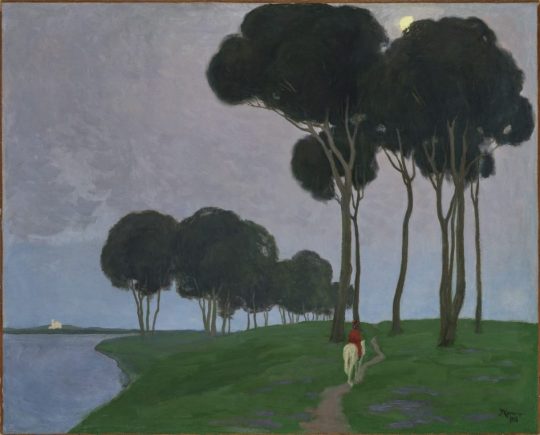
Landscape with Rider, Aleksanders Romans (1910)
Pale Moon, Sky Lotus
Pale moon, sky lotus,
Planted by Isis hand,
When Osiris loved her,
Her on the blue blossom nights,
The short, blue blossom nights.
Stretching the root-rays earthwards,
Ripening desire, ripening love,
Pale moon, sky lotus,
Planted by Isis hand.
Sailing away on a golden boat,
Osiris travelled dark nights,
Long, dark autumn nights, —
Desire wilts, love wilts,
Even Isis’ flower wilts,
Pale moon, sky lotus.
- Aspazija (From her collection: In The Time Of Asters - Autumn Poems, 1928)(my translation from the Latvian - see read more for the Latvian original)
BĀLAIS MĒNESS, DEBESS LOTOSS
Bālais mēness, debess lotoss,
Stādīts pašas Iziss rokas,
Oziriss kad iemīlēja
Viņu zilās ziedoņnaktīs,
Īsās, zilās ziedoņnaktīs.
Zemē stiepjot staru saknes,
Plaucē ilgas, plaucē mīlu
Bālais mēness, debess lotoss,
Stādīts pašas Iziss rokas.
Aizbrauc prom ar zelta laivu
Oziriss pa tumšām naktīm,
Garām, tumšām rudens naktīm. —
Novīst ilgas, novīst mīla,
Novīst pati Iziss puķe,
Bālais mēness, debess lotoss.
- Aspazija
1 note
·
View note
Photo
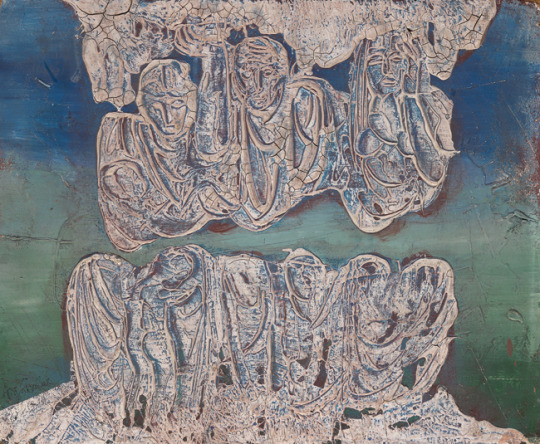
War Caryatids, by Džemma Skulme (1925-2019), Latvian painter.
Adonis is dead!
Nymphs sadly bow heads on shoulders
Like shivering pigeons
Letting their long green hair hang down,
Fountains gasp,
And tearful leaves murmur in the trees:
They refuse to green-up anymore
And toss downwards brown onto waves.
Amongst the reeds the mermaids wring their pale hands:
“Adonis is dead!”
And with the pale sun and moon -
With the gods they left, as did the rest. -
Pan’s silver flute sounds in our forests no more,
No whooping bacchanal bands dance any longer,
Sad Bacchus sleeps amidst the overturned wind cups
The sweet juice gives way to salty tears
No more he rides a panther-pulled chariot
The broken ivy reins, lie limp on the ground:
“Adonis is dead!”
Climbing cold up from the earth is
Pluto’s breath:
Withering all, that blooms and buds in sunlight,
Black cypresses, like smoke turned into vegetation,
Pointed columns against the blue of the sky,
A mourning choir gathered at the divine tomb:
“Adonis is dead!”
Laid underground lying
On black tables is Adonis
His white flesh glows
Cut to pieces in golden bowls
Steaming life-blood poured in crystal dishes
Mounds of pomegranates alongside
Invite tardy guests to the subterranean banquet:
“Adonis is dead!”
The ruler of the underworld is a glutton,
Eating the offered body,
The icy lips are not warmed, in drinking the warm blood,
The bitter cry sounds around the world:
“Adonis is dead!”
- Aspazija (From her collection: In The Time Of Asters - Autumn Poems, 1928)
(my translation from the Latvian - see read more for the Latvian original)
ADONISS IR MIRIS
Nimfas liec skumji galvu uz pleca,
Kā dūjiņas salstot,
Gari uz leju tām nokaras zaļie mati,
Avoti elso,
Un lapas čab raudot pie kokiem:
Negrib tās zaļot vairs
Un brūnas kaisās uz viļņiem,
Vīstošos meldros nāras lauž baltās rokas:
«Adoniss ir miris!»
Un līdzi bāl saule un mēness —
Līdzi ar viņu aizgāja dievi, i citi visi. —
Neskan mums mežos vairs Pāna sudraba fleitas,
Netrako dejās vairs bakhantu kliedzošie bari,
Bēdīgs guļ Bakhus pie apgāztiem vīna kausiem,
Sulīgas saldmes vietā tek asaru sāļums,
Nebrauks viņš viesuļos vairs savā panteru jūgā,
Pārrautie efeju groži velkas šļaugi gar zemi:
«Adoniss ir miris.»
Auksta kāpj augšup no zemes
Plūtona dvaša:
Stindzina visu, kas saulē un ziedos plaucis.
Melnas cipreses it kā ziedokļadūmi
Smailā stabā stiepjas pret debesu zilgmi,
Sēru korī stāv koki ap dievišķo kapu:
«Adoniss ir miris!»
Pazemē nolikts guļ
Uz melniem galdiem Adoniss —
Baltā miesa mirdz,
Sagriezta zelta bļodās,
Kūpošā asins lejas kristāla traukos,
Granāta augļi sakrauti kaudzē guļ blakām,
Aicinot veļu viesus uz pazemes dzīrēm:
«Adoniss ir miris.»
Rijīgs ir zemzemes valdnieks,
Ēdot ziedoņa miesu, —
Ledainās lūpas nesilst, siltas asinis dzerot, —
Izmisis sauciens skan visai pasaulei cauri:
«Adoniss ir miris.»
6 notes
·
View notes
Photo

Image: Why didn’t you wake me? (2013) Installation by Latvian artist Ginters Krumholcs.
Hamlet’s Monologue
When the ground is covered with shimmering autumn vapours
And has swallowed up the last leaves of the trees,
The moon shines wanly in the sky,
Like a corpse,
Then the sorrowful times begin again,
As Hamlet rises once more from the grave
And, wrapped in a black toga,
Holds forth his monologue:
“Has life improved after me?
With fewer tragedies? Less crime?
It seems better to be suffocated in elemental sleep!
Or hang unseen like a foggy patch
Over the world’s inhabitants,
Filled with the new seeds of stars, -
Or to be formed in marble,
So smooth and white,
Laid in a mountain bed untouched, unwrinkled,
Not under the sculptor, nor chipped by his hand,
Where the chisel splits, and the sparks fly?
Who thirsts for a hot-bodied life?
Who would climb the tower of beauty?
Or yet reach the pinnacle of perfection,
When earthly life is filled with such struggle?
“It is hard for who has not been, to be,
But much harder for who has been, to not be!”
- Aspazija (Prologue to her collection: In The Time Of Asters - Autumn Poems, 1928)
(my translation from the Latvian - see read more for the Latvian original)
HAMLETA MONOLOGS
Kad zemi pārklāj gluzdošs rudens tvaiks
Un rīst vispēdējā no kokiem lapa,
Pie debess palsi atspīd mēnesis
Kā miroņģindenis,
Tad sākas atkal grūtsirdības laiks,
Kur Hamlets pieceļas ikreiz no kapa
Un, aptērpies ar melnu togu,
Tur monologu:
«Vai dzīve labāka pēc manis tapa?
Vai mazāk traģikas? vai mazāk ziegu?
Šķiet, labāk dusēt elementu miegu!
Vai karāties kā miglas plankumam
Virs zemes dzimtām nesaredzamām,
Ar jaunu zvaigžņu sēklu pildītām, —
Vai būt kā marmoram, kas gluds un balts
Dus kalnu gultā neaizskarts, bez krokām,
Ne nākt zem tēlnieka un viņu roku kalts,
Kur, dzirkstēm šķiestot, šķeļ to asais kalts?
Kam karstas dzīvības slāpt?
Kam daiļumu tornī kāpt
Un pilnības kalnā jau būt,
Kad zemē ar joni grūt?——Gan grūti ir nebijušam būt,
Bet grūtāk par grūt’
Ir jau reiz bijušam ne vairs būt!——»
- Aspazija (1865-1943)
2 notes
·
View notes
Photo
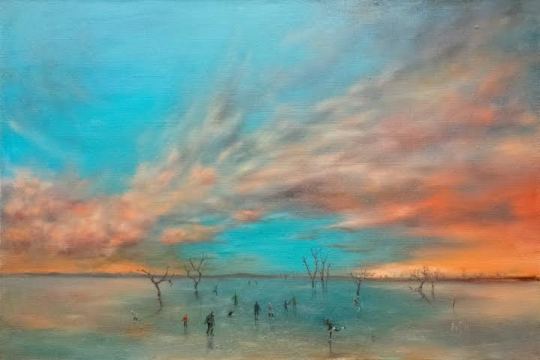
As an unwritten poem
As an unwritten poem
Clouds flowed with the wind,
But in my withdrawal,
I saw no clouds.
As an unwritten poem
Snowflake phalanxes fell,
But in my withdrawal,
I hammered joy to the cross.
As an unwritten poem
Sunset’s clarion call blazed in the window,
But in my withdrawal,
I only whiffed the storm’s shreds…
As an unwritten poem…
- Ārija Elksne (Latvian poet, 1928-1984)
Painting by Latvian artist, Ilze Smildzińa (from her Daļa ceļa - Part of the road - exhibition)
(My translation; read more for the Latvian original)
Kā nepierakstīta dzeja
Kā nepierakstīta dzeja
Mākoņi plūda ar vēju,
Bet, sevī ierāvusies,
Es mākoņu neredzēju.
Kā nepierakstīta dzeja
Sniegpārslu pūkas krita,
Bet, sevī ierāvusies,
Es prieku pie krusta situ.
Kā nepierakstīta dzeja
Logā pūta saulrieta taures,
Bet, sevī ierāvusies,
Es tvēru vien vētras aurus…
Kā nepierakstīta dzeja…
#arija elksne#latvian poetry#witmonth#latvian art#ilze smildzina#It is WIT month but I am disorganised and have none to read but next best is to generate some for everyone else so here is a poem
3 notes
·
View notes
Photo

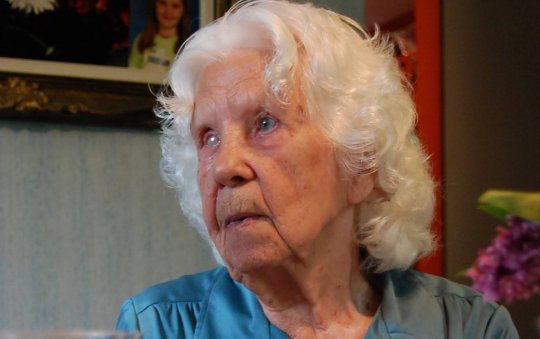


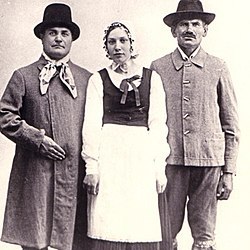

Dundaga Shire, Latvia
I thought I’d learn a bit more about Latvia by looking through the different regions. I particularly want to pick someone associated with each place to make it personal. To make it even more personal I’ll look for opportunities for linking to my parents’ lives, but that will not be always possible since there are lots of nooks, and my parents didn’t really travel widely.
I start with Dundaga - the pointy bit sticking out into the Baltic Sea - in the western Courland region (Kurzeme in Latvian). In some ways it is an odd place to start, since it is one of the least Latvian, since the majority of people living there were not Latvian, but Livonians, speaking the Livonian language, very different to Latvian, and instead much more closely linked to Estonian and Finnish.
The Livonians were great sailors, and the marshlands below Dundaga isolated them from Latvian farm communities helped them maintain their identity into the 20th Century. By sea they connected with their Estonian cousins. However the world wars, and Soviet cultural movements aimed to erase the Livonians as a distinct ethnic and lingustic group.
To some Livonian is now an extinct language. In the top right we see Grizelda Kristiņa (1910-2012) who was the last fluent Livonian speaker alive.
My family connection is that my Dad recalls being confused when their teacher referred to frogs as “vardas”, when to him (and his school friends) they were clearly “koonjas”. The issue was the teacher was teaching them in standard Latvian, while these country kids - living only about 10km from the Estonian border - had internalised many Estonian words. Googletranslate tells me Estonian for frog is “konn” - I guess on the border they took that root and turned into a Latvian word. I don’t know, but I guess that the Livonian word for frog is probably similar to the Estonian - sadly googletranslate doesn’t have Livonian!
10 notes
·
View notes
Text
Notes from a scientist on the current crisis
Over the past several months, the media have reported on a number of scientists’ work attempting to model how the pandemic will behave. Some of the research claims that the worst is over, or that we’re nearly at the end, by postulating that, for example, we’ve almost reached herd immunity or that (most recently, brought to my attention by @bourbakiaxiom) the U.S. is “only” going to have about 66,000-70,000 deaths and that the pandemic will have run its course in this country by the end of June.
I have a PhD in mathematics and I work doing statistical analyses in environmental epidemiology. I do not study infectious disease, but neither do a lot of the people doing these studies, and some of them may not know anything at all about epidemiology. This most recent scientific article was published in a math journal, not a medical or epidemiology journal.
If no epidemiologist is involved with the study, take the results with a very large grain of salt.
Sometimes these stories are reported in publications like the Financial Times. Your first thought upon seeing such an article in such a publication should be “who profits if people believe this?” If the study is used to support the “reopening of the economy”, corporations will recover faster but the death toll will skyrocket.
The conclusions of all of these studies are based on assumptions. Examine those assumptions.
Regarding this most recent study, it was based on data through April 28. It is now less than a week later and there have now been over 67,000 confirmed COVID-19 deaths in the US, meaning there should only be a maximum of 3000 more according to the article–but that seems impossible given that more and more new infections are being confirmed, and a vast number of those infected have not yet been counted as officially recovered. Note also that (a) testing is still far from universal, so the numbers that went into the model are questionable; (b) we do not know whether recovery confers immunity; © as the author acknowledges, any changes to shelter-in-place orders, social distancing, testing, contact tracing etc. would change the predicted death toll.
But also, it’s important to remember: we do not know very much about this virus yet. Scientists–including microbiologists, pharmacologists, epidemiologists, pulmonologists, vaccinologists, and others–are working around the clock to learn more, to figure out how to control the virus. Inevitably, because so much is unknown, there will not be complete agreement among scientists.
Remember: these optimistic articles are playing into what we want to hear. So, please consider carefully before reblogging or retweeting or sharing articles about the pandemic, or even before believing what you read. The scientific community is trying to get us through this, but it takes time to reach consensus and it’s important not to let popular belief go in a potentially deadly direction before the science catches up.
113 notes
·
View notes
Photo

Kindred (2018; silicone, fibreglass, hair) by Patricia Piccinini
“We can see the humanity in her. And then we look at her longer and think, But she’s different, in fact she’s different from her children. But we recognise the relationship between them. It is familiar. And we feel that. And then we realise that the work is not about external difference — which is the difference between us and other animals that we use to justify erecting barriers and driving them to extinction for profit. We realise that this family, this amazing family is completely connected. And that we are all also connected. And this connection is a beautiful thing. She is an amazing expression of nature, even this mediated nature. And she’s valuable. And it’s from that more affirming place that we are able to act. It makes me think of Mary Shelley—she was an abolitionist. So she didn’t believe in slavery—the slavery that made her generation of people wealthy. And because she was an abolitionist she didn’t eat sugar.
“Because slaves made sugar. Now eating sugar is a small thing in someone’s life. But it’s hugely symbolic. And then when she comes to write Frankenstein this whole narrative of the master-slave informs how we relate to the monster who is presented as the slave. Like, completely controlled by the master-father. So I see this beautiful connection between these two stories — Shelley and sugar and Frankenstein and Kindred and palm oil. This idea of how can we treat slaves or nature as badly as we do because we don’t see them as human.”
- Patricia Piccinini, from this great long read
#Patricia Piccinini#art and environment#mary shelley#frankenstein#abolition#extinction#I was reminded of her through reading Olga Tokarczuk since both have been inspired by anatomy#kindred#piccinini#animals
14 notes
·
View notes
Photo
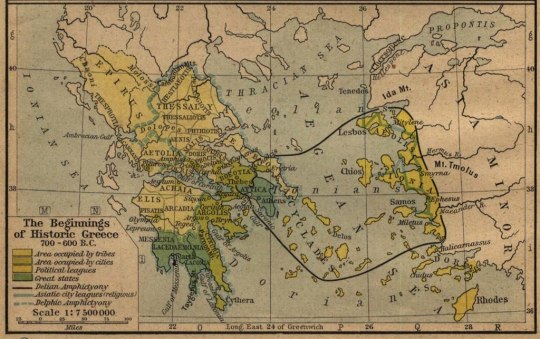
Map of Greece
It’s reminiscent of a great Tao - if you look at it closely, you can indeed see a great Tao made of water and land. But in no place is it as though one were gaining an advantage over the other - they embrace each other reciprocally: earth and water. The Peloponnesian Straits are what the earth give to the water, and Crete what the water gives to the earth.
I do think that the Peloponnese has the most beautiful shape. Its the shape of a great maternal hand, not a human one, that is dipping into the water to check if the temperature is right for a bath.
- from Flights, by Olga Tokarczuk (trans. Jennifer Croft)
3 notes
·
View notes
Photo

What the shrouded runaway was saying
So go, sway, walk, run, take flight, because the second you forget and stand still his massive hands will seize you and turn you into a puppet, you’ll be enveloped in his breath, stinking of smoke and fumes and the big rubbish dumps outside of town. He will turn your brightly coloured soul into a tiny flat one, cut out of paper, of newspaper, and he will threaten you with fire, disease and war, he will scare you so you lose your peace of mind and cease to sleep. He will mark you and record you in his records, provide you with the documentation of your fall. He’ll occupy your thoughts with unimportant things, what to buy, and what to sell, where things are cheaper and where they’re more expensive. From then on you will worry over trifles - the price of petrol and how that will affect the payments on our loans. You will live every day in pain, as though your life were a sentence. But for what crime? Committed when and by whom? You will never know.
- Flights, by Olga Tokarczuk (trans. by Jennifer Croft)
#flights#olga tokarczuk#jennifer croft#women in translation#perspective#largs bay#myphotography#polish literature
9 notes
·
View notes
Quote
How lost they must feel in the world, where all instructions, all the lyrics of all the stupidest songs, all the menus, all the excruciating pamphlets and brochures - even the buttons in the lift! - are in their private language. They may be understood by anyone at any moment, whenever they open their mouths. They must have to write things down in special codes. Wherever they are, people have unlimited access to them - they are accessible to everyone and everything! I heard there are plans in the works to get them some little language of their own, one of those dead ones no one else is using anyway, just so that for once they can have something just to themselves.
Flights, Olga Tokarczuk (trans. by Jennifer Croft)
8 notes
·
View notes
Photo

Juvenile Pacific Gull, Largs Bay
4 notes
·
View notes
Photo

(Drawing by Vincent van Gogh)
“I want to add an important side note: that artists have learned to employ these ways of seeing does not mean that they don’t also see what we see. They do. They just see more because they’ve learned how to turn off their minds’ tendency to jump to conclusions. (This is why it is so frustrating that funding for arts programs in schools has been decimated. And those cuts stem from a fundamental misconception that art classes are about learning to draw. In fact, they are about learning to see.)”
- Ed Catmull, from Creativity Inc. Ed was a founder and long-time CEO of Pixar.
#ed catmull#drawing#art#vincentvangogh#arteducation#creativity#seeing#pixar#animation#what I have been reading recently
20 notes
·
View notes
Photo
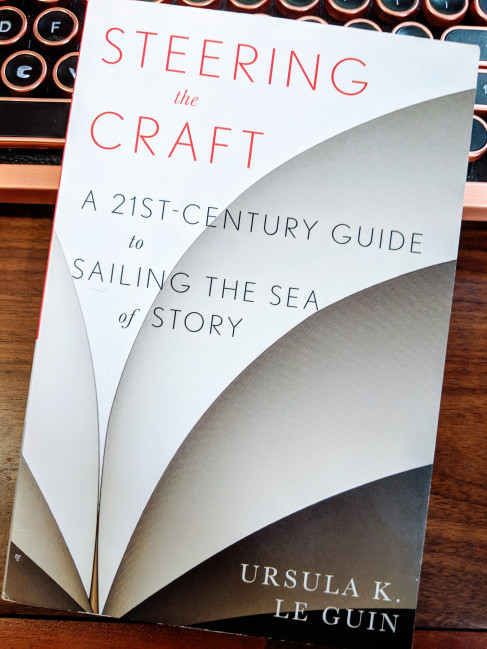
Steering Her Craft
As a child I read Ursula Le Guin’s fantasy novel The Wizard of Earthsea, and loved it. When I then started reading the following book of the series, The Tombs of Atuan, I rapidly gave up... my excuse was that it was all underground, and sooooo boring.
I read very little of Le Guin in the years since (I think I read The Left Hand of Darkness in my adolescence), but gradually developed a sense of what a huge influence she had become over the intervening years, amongst both scifi and fantasy writers and readers. As an example, her wisdom would turn up repeatedly in Maria Popova’s BrainPickings. I really respected her - but I still wasn’t reading her.
This year I have read all six of the Earthsea books, just finishing now with the Tales of Earthsea (yes, I realise that is not exactly in order). I totally loved them, and recommend them all. The fact that she would keep coming back to this world from decade to decade is lovely (gosh, I’m sure her publishers gave her every encouragement imaginable too ;) ). It was exciting to see how she made this world she formed, go deeper and deeper.
Also in my reading this year was her Steering the Craft: A 21st Century Guide to Sailing the Sea of Story. This is a very dangerous book! If you are not careful, all her wonderful examples and guidance will make you desperate to try your hand at creative writing - and who knows what that could lead to? I am trying hard to be self-controlled here... wish me well!
Reflecting back on my youthful aversion to The Tombs of Atuan - what was that really about? It really cannot have been solely due to the underground scenes (I had not minded Bilbo and Gollum under the Misty Mountains the slightest). The realisation I have now is that it was all a simple, unconscious sexism. The protagonists of The Tombs of Atuan were women - girls even! - and I simply did not have the maturity to get involved emotionally with such characters. It shames me now - but it is well to have made this realisation, and to have belatedly made good, now enjoying to the full this wonderful magical archipelago created by Le Guin.
#ursula le guin#earthsea#steering the craft#jmcoster#fantasy writing#tales from earthsea#wizard of earthsea#I really enjoyed J M Costers links about Steering the Craft which also is where I got the image from#it has been a while
5 notes
·
View notes